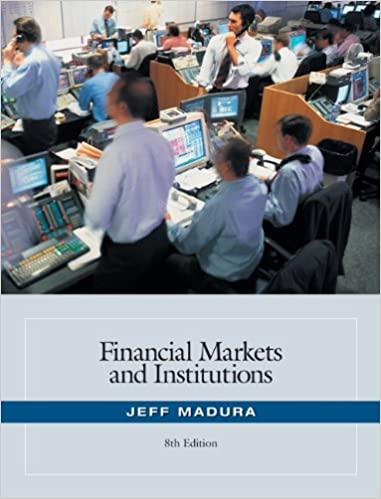Question
Joe and Mary Donaldson, both in their late forties, have one child, Matthew, age 15. Matthew probably will be attending the local state university as
Joe and Mary Donaldson, both in their late forties, have one child, Matthew, age 15. Matthew probably will be attending the local state university as a commuting student beginning in three years. The annual cost of tuition, books, and fees there this year is about $8,500, a total that the Donaldson's expect to grow at about an 8% compound annual rate in each of the next several years.
Joe and Mary view themselves as shrewd investors. Over the years they have accumulated the following diverse list of securities designed to help pay for Matthew's college education:
- 100 shares of Alpha Corp. common stock, traded in the over-the-counter market; current market price is about $30 per share, the same as a year ago; current annual divided is $1.00 per share and is expected to grow at a rate of about 5% per year for the next several years.
- Three tax-exempt municipal bonds issued by the government of the city where the Donaldson's live; each bond has a $1,000 face amount, is selling for about $980 currently, the same price as a year ago, has a 6% annual coupon rate, and is scheduled to mature 4 years from now.
- Five recently acquired zero-coupon bonds issued by Beta Corp. several years ago and scheduled to mature in 5 years at a face value of $1,000 each; current market price of each bond is $920.
- 100 shares of Delta Corp. common stock that is listed on an organized securities exchange; historically, this stock has exhibited a beta of about 1.3; the stock currently is selling for about $7.00 per share and pays no dividend
1) If the risk-free interest rate is now 3% and the market interest rate is 9%, what would the Donaldson's required rate of return, according to the capital asset pricing model, on the Delta Corp. common stock?
Group of answer choices
9.9%
11.7%
10.3%
10.8%
2) Are the Donaldson's actually earning more than the CAPM required rate of return on the Delta Crop. stock?
Group of answer choices
No, because they are not earning any rate of return on the Delta Corp. stock
Yes, because the beta of 1.3 is greater than 1.0
The answer cannot be determined from the information provided
Yes, because the stock is selling at a very low price of $7.00 per share
3) Which of the following will be the compound annual return the Beta Corp. zero-coupon bonds will provide if the Donaldsons hold the bonds until they mature?
Group of answer choices
1.74%
8.70%
1.68%
16.00%
4) Which of the following is the Donaldson's current yield on the Alpha Crop. common stock?
Group of answer choices
33%
3.3%
3.5%
Cannot be determined from the information provided
5) What should happen to the intrinsic value of the Alpha Corp. common stock if Joe and Mary now decide that the stock is much riskier than they have previously been thinking?
Group of answer choices
The intrinsic value of the stock should fall because Joe and Mary should adopt a higher required rate of return on the stock
The intrinsic value of the stock should rise because its increased riskiness will cause speculators to bid up its market price
The intrinsic value of the stock should not change because a stock's intrinsic value is not affected by its riskiness
The intrinsic value of the stock should fall because many investors will begin selling the stock, thus lowering its market price
6) If Joe and Mary's required rate of return on the Alpha Corp. common stock is 10% per year, according tot he constant-dividend-growth formula, Alpha's stock has an intrinsic value of about
Group of answer choices
$10.50 per share
$5.00 per share
$30.00 per share
$21.00 per share
7) The Donaldson have received advice from two sources as to how to invest the $12,500 of sales proceeds from the present portfolio during the next 3-7 years in order to meet the costs of Matthew's college education. One person suggested buying a small piece of unimproved real estate. The other has suggested investing in a real estate investment trust (REIT).
Match the type of real estate investment (A or B) with each of the investment characteristics below:
A. Purchase of a piece of unimproved real estate
B. Investment in REIT
- Lower degree of liquidity?
- Higher transfer costs?
- Higher degree of diversification?
- Lower opportunity for dollar cost averaging?
- Lower degree of potential legal liability?
Step by Step Solution
There are 3 Steps involved in it
Step: 1

Get Instant Access to Expert-Tailored Solutions
See step-by-step solutions with expert insights and AI powered tools for academic success
Step: 2

Step: 3

Ace Your Homework with AI
Get the answers you need in no time with our AI-driven, step-by-step assistance
Get Started


